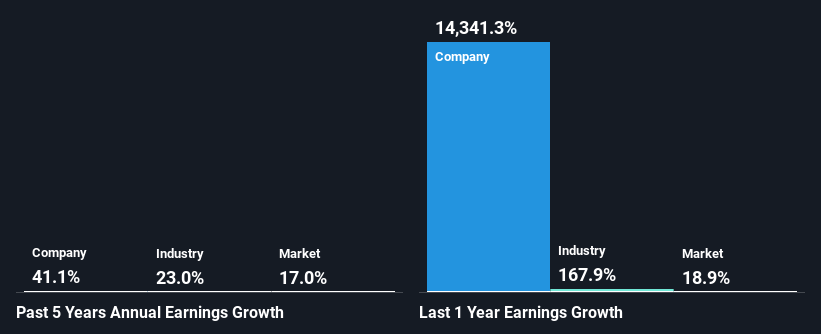Are Freehold Royalties Ltd.'s (TSE:FRU) Fundamentals Good Enough to Warrant Buying Given The Stock's Recent Weakness?
With its stock down 5.7% over the past week, it is easy to disregard Freehold Royalties (TSE:FRU). But if you pay close attention, you might find that its key financial indicators look quite decent, which could mean that the stock could potentially rise in the long-term given how markets usually reward more resilient long-term fundamentals. Particularly, we will be paying attention to Freehold Royalties' ROE today.
Return on equity or ROE is an important factor to be considered by a shareholder because it tells them how effectively their capital is being reinvested. Put another way, it reveals the company's success at turning shareholder investments into profits.
Check out our latest analysis for Freehold Royalties
How To Calculate Return On Equity?
The formula for return on equity is:
Return on Equity = Net Profit (from continuing operations) ÷ Shareholders' Equity
So, based on the above formula, the ROE for Freehold Royalties is:
12% = CA$105m ÷ CA$898m (Based on the trailing twelve months to March 2022).
The 'return' is the yearly profit. Another way to think of that is that for every CA$1 worth of equity, the company was able to earn CA$0.12 in profit.
What Has ROE Got To Do With Earnings Growth?
We have already established that ROE serves as an efficient profit-generating gauge for a company's future earnings. Depending on how much of these profits the company reinvests or "retains", and how effectively it does so, we are then able to assess a company’s earnings growth potential. Assuming everything else remains unchanged, the higher the ROE and profit retention, the higher the growth rate of a company compared to companies that don't necessarily bear these characteristics.
Freehold Royalties' Earnings Growth And 12% ROE
At first glance, Freehold Royalties seems to have a decent ROE. Be that as it may, the company's ROE is still quite lower than the industry average of 26%. That being the case, the significant five-year 41% net income growth reported by Freehold Royalties comes as a pleasant surprise. We believe that there might be other aspects that are positively influencing the company's earnings growth. For instance, the company has a low payout ratio or is being managed efficiently. Bear in mind, the company does have a respectable ROE. It is just that the industry ROE is higher. So this also does lend some color to the high earnings growth seen by the company.
As a next step, we compared Freehold Royalties' net income growth with the industry, and pleasingly, we found that the growth seen by the company is higher than the average industry growth of 23%.
Earnings growth is a huge factor in stock valuation. It’s important for an investor to know whether the market has priced in the company's expected earnings growth (or decline). This then helps them determine if the stock is placed for a bright or bleak future. If you're wondering about Freehold Royalties''s valuation, check out this gauge of its price-to-earnings ratio, as compared to its industry.
Is Freehold Royalties Using Its Retained Earnings Effectively?
The really high three-year median payout ratio of 115% for Freehold Royalties suggests that the company is paying its shareholders more than what it is earning. In spite of this, the company was able to grow its earnings significantly, as we saw above. Although, it could be worth keeping an eye on the high payout ratio as that's a huge risk. Our risks dashboard should have the 3 risks we have identified for Freehold Royalties.
Besides, Freehold Royalties has been paying dividends for at least ten years or more. This shows that the company is committed to sharing profits with its shareholders.
Summary
In total, it does look like Freehold Royalties has some positive aspects to its business. Namely, its high earnings growth, which was probably achieved due to its respectable ROE. However, the considerably low reinvestment rate does diminish our excitement to a certain extent. That being so, a study of the latest analyst forecasts show that the company is expected to see a slowdown in its future earnings growth. Are these analysts expectations based on the broad expectations for the industry, or on the company's fundamentals? Click here to be taken to our analyst's forecasts page for the company.
Have feedback on this article? Concerned about the content? Get in touch with us directly. Alternatively, email editorial-team (at) simplywallst.com.
This article by Simply Wall St is general in nature. We provide commentary based on historical data and analyst forecasts only using an unbiased methodology and our articles are not intended to be financial advice. It does not constitute a recommendation to buy or sell any stock, and does not take account of your objectives, or your financial situation. We aim to bring you long-term focused analysis driven by fundamental data. Note that our analysis may not factor in the latest price-sensitive company announcements or qualitative material. Simply Wall St has no position in any stocks mentioned.
Join A Paid User Research Session
You’ll receive a US$30 Amazon Gift card for 1 hour of your time while helping us build better investing tools for the individual investors like yourself. Sign up here

